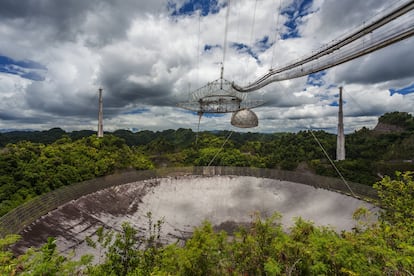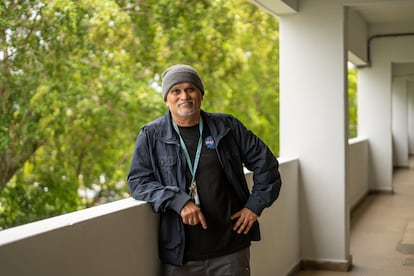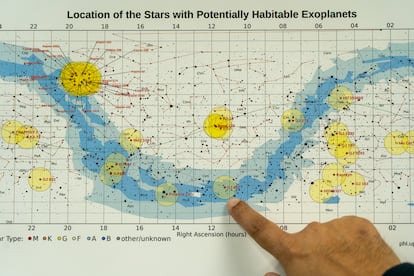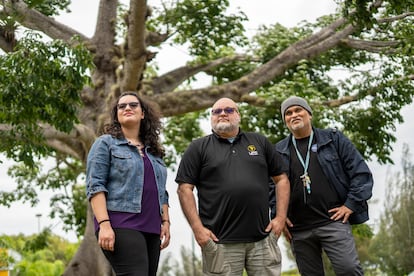The challenge of Puerto Rico’s Arecibo Observatory: What will fill the void left by the world’s most powerful radio telescope?
This instrument was a reference for listening to the universe for more than half a century, until it collapsed in 2020. Its legacy includes great discoveries, and there is a lot of anticipation over what will replace it


In a corner of his laboratory, Professor Abel Méndez, director of the Planetary Habitability Laboratory of the University of Puerto Rico, preserves one of his most cherished memories about the Arecibo radio telescope, which was, for more than 50 years, the biggest in the world. On simple sheets posted on the wall, you can see the schedule that astronomers and scientists from around the world were assigned to spend between two and four hours using the radio telescope and listening to the universe. His own initials, Méndez shows, are there: AM.

Obsessed with exploring habitability on other planets or exoplanets, starting in 2017 the professor frequently went to the Arecibo Observatory, about 30 minutes by car from the university, to focus on the stars. “There are some very active stars, like red dwarfs, and others like the Sun, which could be said to be rather quiet,” he explains. “What I used the radio telescope for was to observe which are the most stable stars because, around them, it is more likely that planets with a more habitable atmosphere exist.” Arecibo, in some way, allowed him to know what to prioritize in his research.
That was until, on December 1, 2020, the radio telescope collapsed.
In Puerto Rico, and among the scientific community, everyone seems to remember how they found out about the fall of the giant telescope, which had a 300-meter spherical reflector dish, only surpassed in 2016 by China’s Five-hundred-meter Aperture Spherical Telescope (FAST). “I was at my house and, although it didn’t take me by surprise, I was silent for about two minutes,” Méndez recalls. “The press called me and I didn’t want to go on air or go see what had happened up close.”

Professor Ángel Acosta, a physicist and geologist who used the radio telescope’s data for teaching and scientific communication, found out from the media. “To this day I have not been able to finish watching the video of the collapse,” he says, referring to a series of images that were recorded with a drone and captured the moment when the Gregorian reflector of the radio telescope fell on the platform.
Luisa Fernanda Zambrano, a Colombian planetary scientist who has worked with the Arecibo radio telescope in Puerto Rico since 2013, observing and characterizing asteroids, remembers that day with pain: “I cried, my team cried, we were all crying,” she says from her office in the United States, where she works with the Florida Space Institute of the University of Central Florida.
But, beyond the tragedy, Arecibo left an unimaginable scientific legacy. For example, in 1965, it revealed that Mercury’s rotation lasts 59 days; in 1974, it discovered the first binary pulsar, which led physicists Russel Hulse and Joseph Taylor to win a Nobel Prize. In 1981, it produced the first map of the surface of Venus, and in 1992 it identified the first exoplanet. Over the years, it revealed that there were asteroids that passed by in pairs or in trios. In November 1974, furthermore, and thanks to the fact that Arecibo not only listened to the Universe, but also had a radar that allowed it to emit signals — the most powerful in the world — it sent the first message into space. It was information about our Solar System, the Earth and human beings, and it was sent to a star cluster called M13, which is at a distance of 25,000 light years.

But Arecibo also crept into popular culture. It appeared in the movies Golden Eye, Contact and Species. “It was a tourist destination and a mandatory stop for scientists from the island or who were coming to the island,” says Acosta. In 2023, when there were only ruins of the telescope left, Ashley Ann Cariño represented Puerto Rico at the Miss Universe pageant with a typical costume that paid tribute to Arecibo. It was an allusion to nostalgia, to how the island had lost one of the most captivating and powerful instruments for listening to space.
Zambrano, passionate about asteroids and part of the NASA program that used the radio telescope to characterize which ones could be a danger to Earth, is still working with the observations she made with Arecibo. “The data taken with this telescope continue to be processed, because they are an enormous legacy that it left us,” he says. She recognizes that in part she left Puerto Rico because her work instrument had ceased to exist and, without Arecibo, the possibilities of maintaining a good salary were low.
What comes after the collapse
Narrating the collapse of Arecibo is a scientific horror story. The radio telescope had just survived Hurricane Maria in 2017 and the earthquake in January 2020, when an auxiliary cable broke in August of that same year. All observations stopped while another cable was brought from the United States for repairs. But in November, just months later, a main cable came loose and the entire observatory was evacuated. In December, the radio telescope collapsed and, despite a strong campaign for the National Science Foundation (NSF) to repair it, a forensic study showed that it was not viable. In August 2023, all facilities closed and it was learned that the NSF opened a call for projects that wanted to use the space.

The project that was chosen was Arecibo C3, an initiative that hopes to open its doors in June of this year through a pilot program. There is still a bit of a mystery about what is going on in there. “The new Arecibo Center for culturally relevant and inclusive science education, with computational skills and community participation (C3), will continue the Arecibo Observatory’s legacy of leadership within Puerto Rico and the STEM community through education, outreach and workforce development,” the NSF told this newspaper in a brief statement.
That is, Arecibo will no longer devote itself to astronomy, but to various sciences. Méndez, however, believes that there will be an emphasis on space sciences, since its executive director will be the Puerto Rican astronomer Wanda Díaz Merced, known for converting data into audible sound, since she is blind.
There is expectation about what will happen next. Arecibo is now surrounded by a certain enigma. Something that worries Méndez and other scientists is what will happen to the other instruments that the Arecibo Observatory had besides the fallen radio telescope. “In particular, we want to know what will happen with a 12-meter radio telescope that continues to allow important observations,” says Mendéz, explaining that together with a group of scientists they asked the NSF to be able to enter the premises to check its status.
Although this question remains without a specific answer, the NSF explained in a message that a spectrometer and two photometers were sent to Culebra Island, also in Puerto Rico, to continue doing atmospheric research. “The Arecibo C3 team has access to the instrumentation that remains on site and can choose to incorporate it into some science, technology, engineering and mathematics educational activities,” said the note, adding that they will consider proposals to use them under subsidy.
In Puerto Rico, there are feelings of suspense and hope. But C3 won’t have it easy. What Arecibo left to the island, to science and to humanity, are shoes that are difficult to fill.
Sign up for our weekly newsletter to get more English-language news coverage from EL PAÍS USA Edition









































